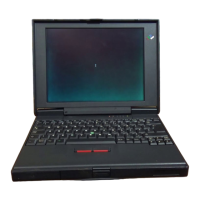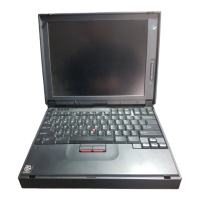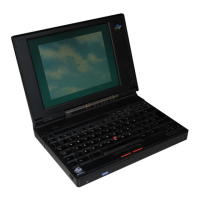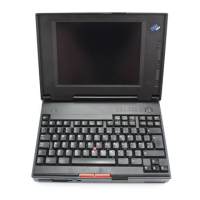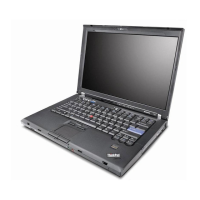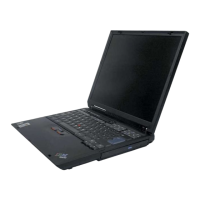Do you have a question about the IBM ThinkPad 310ED and is the answer not in the manual?
| Manufacturer | IBM |
|---|---|
| Model | ThinkPad 310ED |
| Category | Laptop |
| Processor | Intel Pentium |
| RAM | 16 MB |
| RAM Expandable To | 80MB |
| Storage | 1.2 GB HDD |
| Resolution | 800 x 600 |
| Operating System | Windows 95 |
| Battery Life | 2 hours |
| Ports | Serial, Parallel, VGA |
| Expansion Slots | PCMCIA |
Describes the physical locations of computer components, ports, and connectors on the front, rear, and bottom views.
Explains the meaning and function of various system status indicators like battery, numeric lock, caps lock, and power status.
Details how to power the computer using the AC Adapter and the battery pack, including their functions.
Explains how to use the built-in TrackPoint III pointing device for navigation and selection.
Provides instructions on how to clean the removable cap of the TrackPoint III pointing device.
Explains how to use the Fn key in combination with other keys for special functions and shortcuts.
Describes how to enable and use the keyboard's numeric keypad functionality.
Lists crucial precautions to prevent physical damage to the computer and its components.
Provides instructions on how to safely transport the computer to prevent damage to hardware and data.
Explains the prompts and screens that appear when the computer is powered on.
Details how to use the built-in Notebook Manager for system configuration and settings.
Covers setting, changing, removing, and entering system passwords for security.
Details power management settings, time-outs, and special power-saving features.
Describes how to control display settings, including device selection and brightness.
Provides information on using the computer's LCD and connecting an external monitor.
Details the steps required to connect an external monitor to the computer.
Explains how to use SVGA video modes for higher resolutions on LCD and external displays.
Covers the installation and usage of PCMCIA cards for expanded functionality.
Describes the built-in audio capabilities, including sound chip and speakers.
Explains how to connect and use the external diskette drive.
Details how to use the computer's CD-ROM drive for accessing compact discs.
Explains the situations requiring battery charging and approximate charging times.
Provides guidelines for maintaining battery pack health and longevity.
Details the procedure for safely removing and installing the computer's battery pack.
Explains how to check battery status using the power status indicator and fuel-gauge icon.
Provides methods to save battery power for extended operation time.
Explains how to use the computer's built-in Advanced Power Management (APM).
Details how to reduce LCD brightness to conserve battery power.
Describes the use of standby and hibernation modes for power saving.
Explains the standby mode and how to resume normal operation.
Explains hibernation mode for significant power saving, including file creation.
Details the process of creating a hibernation file for the operating system.
How to set, change, remove, and enter a Power-On password for system startup security.
How to set, change, remove, and enter a Setup password for BIOS/Notebook Manager access.
Explains how to attach physical locks or chains to secure the computer.
Describes how to affix a custom engraved nameplate for identification.
Step-by-step guide for removing and installing a new hard disk drive.
Instructions for inserting PCMCIA cards into the computer's available slots.
Procedure for safely removing PCMCIA cards from the computer.
How to install DIMMs to increase the computer's memory capacity.
Detailed steps for installing a Dual Inline Memory Module (DIMM).
Instructions for connecting an external keyboard to the computer.
How to connect a parallel printer to the computer.
Lists the software pre-installed and required for computer operation.
Guides on installing the operating system and necessary device drivers.
Steps to create diskettes for installing drivers and applications.
Procedures for installing DOS Version 7.0 and its device drivers.
Procedures for installing Windows Version 3.11 and its device drivers.
Procedures for installing Windows 95 and its device drivers.
Guides for installing display drivers, PC Card software, audio support, and manager programs.
Lists common problems, their actions, and frequently asked questions with answers.
Lists Power-On Self-Test (POST) error codes and their corresponding actions.
Explains error codes that appear during normal computer operation.
Information on how to contact IBM for service and support when problems occur.
A guide for documenting computer problems for efficient service reporting.
Details on obtaining help and support during the warranty period via phone and other services.
Information on IBM's courier repair service for mobile products.
Information on upgrading warranty service and available repair options.
How to obtain operating system updates like ServicePaks or corrective service diskettes.
How to prevent conflicts arising from new hardware installations by checking resources.
Summarizes available system resources, including IRQ, I/O, and memory addresses.
Introduces the Phoenix Card Manager utility for managing and configuring PC Cards.
Utility to configure PC Cards, optimize performance, and add features.
Explains the EPD utility for monitoring and logging PC Card events.
A DOS utility to modify and allocate system resources like I/O, IRQ, and DMA.
Utility to manage and configure PC Cards, view status, and run diagnostics.
How to resolve resource conflicts when configuring PC Cards automatically or manually.
Steps to resolve PC Card configuration conflicts using the PCMRMAN utility.
How to set up associations between PC Card events and system actions.
Explains when it is necessary to use the BIOS Utility for computer configuration.
Instructions on how to access, navigate, and exit the BIOS Utility setup screens.
How to configure basic system parameters like date, time, diskette, and hard disk drives.
Setting the default display device (LCD or external monitor) on boot-up.
How to set security parameters for diskette drives, hard disk drives, and system boot behavior.
Configuration of serial and parallel port base addresses and operation modes.
How to set, change, or remove Setup and Power On passwords.
Setting to enable or disable CardBus PC Card support for compatibility.
Configuration options for power management features like standby and hibernation timers.
How to restore the computer to its default BIOS settings for optimal performance.
Details about the computer's Intel Pentium processor with MMX technology and cache memory.
Information on the computer's built-in 16MB RAM and optional memory modules.
Lists the available storage devices including hard disk, diskette, and CD-ROM drives.
Describes the LCD display technologies (TFT/DSTN) and resolution support.
Details the keyboard layout, TrackPoint III, Fn key functions, and numeric keypad.
Information on the computer's built-in audio capabilities and Sound Blaster Pro compatibility.
Lists all external ports and connectors available on the computer.
Standards for high-quality diskettes to ensure optimal performance from diskette drives.
Information on IBM power cords, including part numbers and country availability.
Outlines the terms and conditions of IBM's limited warranty for the computer.
How to obtain warranty service for the computer, including contact information.
Details limitations, exclusions, and conditions of the provided warranty.
Defines IBM's liability limits concerning product defects and damages.
Contains disclaimers regarding product availability, intellectual property, and user responsibility.
Lists trademarks of IBM Corporation and other companies for products and services.
FCC and other regulatory statements regarding electronic emissions compliance.
States the product's compliance with Energy Star guidelines for energy efficiency.

